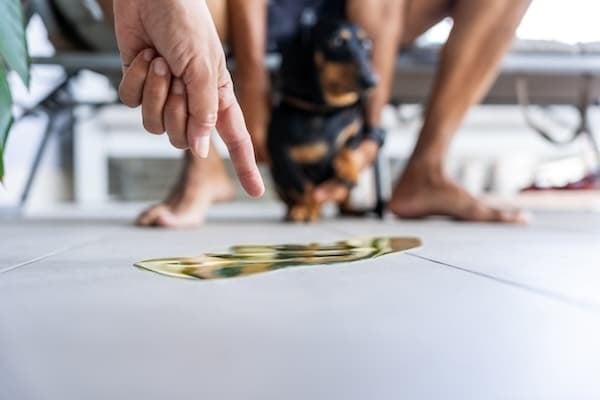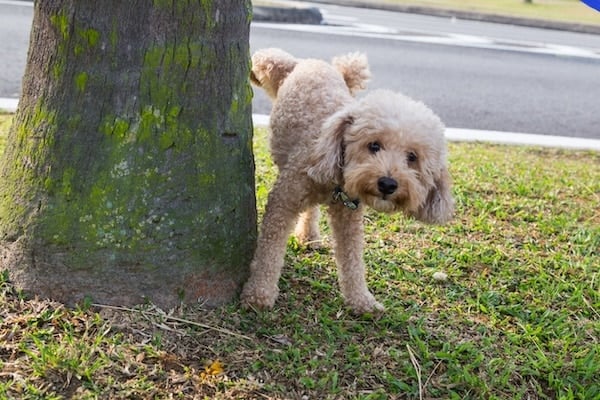- This post contains affiliate links. Read more here.
- Not a substitute for professional veterinary help.
If you’re wondering if it’s possible to house train an older dog, you’re in luck! While the process is not without challenges, potty training an adult dog can be accomplished with a bit of effort and some positive reinforcement.
We reached out to Sara Hawn, CPDT-KA, a certified fear-free trainer and a canine behavior manager at Arizona Animal Welfare League, Arizona’s oldest and largest no-kill shelter, for step-by-step instructions and tips on how to potty train an adult dog.
Whether your dog is brand-new to house training or just needs a refresher course after having some accidents, here’s what you need to know to help your pup learn to poop and pee in the right place.
Can an Older Dog Be Potty Trained?
In short, yes! “All dogs can learn to be potty trained, no matter their age,” says Hawn.
In fact, there’s not much difference between training a puppy and an adult. Unless you have a senior dog who’s experiencing issues of incontinence or Canine Cognitive Dysfunction, your best bet is to spend some time on potty training basics. The biggest challenge will be devoting the time to the training and having patience with the process.
“Consistent scheduling, taking them out when they wake up, before they go to sleep, and about 30-60 minutes after they eat or drink are all important,” explains Hawn. Here’s what to do.
How To Potty Train a Rescue Dog
According to Hawn, consistency will be your number one most effective tool when it comes to potty training a rescue dog. As Hawn points out, “Older dogs who haven’t been potty trained before have had a lot of time to practice going when and where they please.”
To start with, put your dog on a consistent potty schedule. Hawn recommends taking dogs outdoors to go potty at the following times:
- When they wake up
- 30-60 minutes after every meal
- Before they go to sleep
These are the key times a dog is likely to need to pee and poop, and by building a predictable routine, you will help your dog learn to associate certain times of the day with potty breaks.
When not working on potty training, keep your dog somewhere that’s easy to clean up. Dog gates and large playpens can help. You may also want to remove any items that you wouldn’t want to be damaged should your dog have an accident nearby.
“This will help limit your frustration as you are working with your dog,” adds Hawn.
Whenever your dog toilets in the preferred location, make sure to celebrate and reward, whether it’s with treats, verbal praise, or both.
How to potty train an adult dog in an apartment
If you are potty training in an apartment with limited access to the outdoors, you may want to consider using potty pads. These will help define a safe space for your dog to potty indoors and will help absorb any pee or poop away from the floor.
Resist the urge to spread them out all over the home or in all of the locations your dog has peed before. Place them in one location, and one location only.
Dealing with accidents
Accidents are an inevitable part of the potty training process, so don’t yell or chase your dog when you catch them having an accident. This will do nothing to help your pup learn the correct behavior. Instead, if you see your dog peeing or pooping in the house:
- Immediately make a noise to interrupt and get their attention (for example, “Uh uh!” or clapping your hands).
- Quickly go to your dog and gently take them to the correct location, whether that’s outdoors or on a potty pad. Hover in that correct location with your dog for a couple of minutes. If they start going again, celebrate and reward. If they don’t, return inside and clean up the mess.
- Clean up the mess using an enzymatic cleaner like Nature’s Miracle, which will dissolve the pheromones that a regular household cleaner won’t remove. Dogs tend to return to locations where they smell those pheromones to urinate or defecate again.
- Don’t punish your dog for an accident you don’t see happen. By the time you find the accident, they will forget they’ve done it at all! All you can do is clean up the accident and try to catch the next one.

Carolina Santos Torre via iStock
How To Re-Potty Train an Adult Dog Who’s Having Accidents
If you’re wondering how to retrain a dog to stop peeing in the house, the first step is to bring them to the vet, says Hawn. You’ll want to figure out the reason why they have reverted to their pre-potty-trained ways.
“It’s not common for potty-trained dogs to revert suddenly without some kind of medical cause. Accidents may be caused by UTIs, other infections, or other age-related diseases that cause incontinence. If the cause is something more permanent, talk to your vet about possible management strategies, including belly bands, dog diapers, or long-term medications,” she recommends.
Once any medical causes have been ruled out, consider any changes to your dog’s environment or schedule. For example, moving to a new home or changing up the normal potty schedule could cause them stress or confusion about where and when to go. Bringing a new dog into the home could also cause the existing dog to have accidents, especially if the new dog isn’t yet potty trained and is marking indoors.
“If your dog has begun pottying in the house after bringing in a new dog, make sure you are cleaning with an enzymatic or hydrogen peroxide-based cleaner to remove any scent left over. You can also try pheromone-based products to lower stress and inter-dog tension, like Adaptil,” said Hawn.
Once you’ve identified and addressed the potential root cause of a dog’s accidents, you’ll then want to establish a new potty training schedule, ensuring that your dog has plenty of breaks throughout the day to go to the potty.
Sample Potty Training Routine
Here is a sample potty training schedule to follow. Keep in mind that smaller dogs have smaller bladders and may need more frequent breaks than larger dogs.
Morning (6am – 9am)
- Take your dog to go potty as soon as they wake up
- Feed your dog breakfast
- 30 to 60 minutes after breakfast, take your dog out for another potty break
Mid-morning (10am – 11am)
- If your dog didn’t potty after breakfast, give them another break around this time
Mid-afternoon (2pm – 4pm)
- Give your dog a walk or another potty break in the afternoon
Evening (5pm – 8pm)
- Feed your dog dinner and then wait 30 to 60 minutes afterward to take your dog out for a potty break
- Give your dog a final potty break before they go to bed to prevent any overnight accidents
How To Supervise a Dog in Potty Training
Supervising your dog during the house training process will help you catch accidents and teach your dog the correct location to go. Set yourself up for success by blocking access to other rooms so that they can’t sneak into another room and have an accident that you might miss. It’s especially important to prevent them from entering carpeted rooms or accessing the plant they always pee on.
Confine your dog to a safe space where an accident won’t matter, like a bathroom or kitchen with a tile floor, with an X-pen. If your dog has an accident in that confinement space, it’s ok. Teach them that everywhere else in the house is off-limits for peeing and pooping first. Once they’ve learned that, it will be easier to generalize the information to the final confinement location.

ThamKC via iStock
Tips on Crate Training and Potty Training
“Crate training is a great way to help prevent your dog from practicing unwanted behaviors, like pottying inside,” says Hawn.
By working on both crate training and potty training at the same time, you can set your dog up with a consistent routine that they can continue into the future. The crate can also act as a safe space to confine your dog when you’re not able to supervise them.
Here are some tips on house training an adult dog while crate training that Hawn recommends:
- “Make sure your crate is large enough for your dog to stand up and turn around, but not much larger. Most dogs are unwilling to potty where they plan to lay, so this setup helps support them in learning how to hold it.”
- “Ensure that you are giving your dog plenty of time outside the crate and plenty of potty breaks, as necessary.”
Tips on Rewards and Positive Reinforcement
“When it comes to potty training, positive reinforcement is the way to go! Dogs respond much better when they’re taught ‘what to do’ as opposed to what ‘not to do,'” says Hawn.
- Cheerlead with a happy voice immediately after your dog has peed or pooped in the correct place. Carry around some treats in your pocket to sweeten the celebration. The feedback must be instantaneous; if you wait until you return home to celebrate and reward, your dog won’t understand why.
- If your dog is allowed to potty in a yard or another outdoor location as well as on walks, make sure to practice and celebrate them there, too. It’s important to potty train at every location your pet is allowed to use.
- Consider using a special, high-value treat just for house training to help motivate your dog to want to toilet in the correct location.
Signs Your Dog Needs To Go
Watch out for these common behaviors that a dog is about to poop or pee:
- Sniffing the ground
- Stopping what they’re doing
- Becoming restless
- Whining or barking
- Circling
- Pacing around an area, especially one they’ve had an accident in before
- Scratching a door or wanting to go outside
- Squatting or lifting their leg
Once a dog is more established in their potty training routine, they may also:
- Try to get your attention by pawing you or making eye contact
- Sit or hover near the door to the potty location
Once you recognize the signs that your dog needs to go, you can direct them to the correct location before an accident occurs.
Further Reading
- How To Help a Dog Who Is Pooping In Their Crate
- A Complete Guide to Using and Choosing Dog Diapers and Wraps
- Training a Rescue Dog: What To Expect in the First Days, Weeks & Months
- How Often Should Dogs Poop Every Day?
- How To Teach Your Dog to Poop on Leash
- How Long Does Potty Training Take? A Timeline



